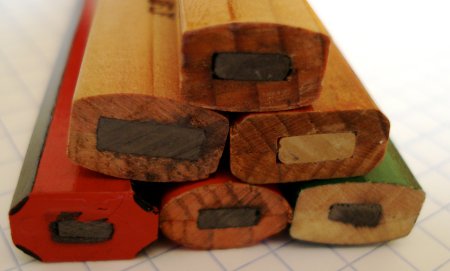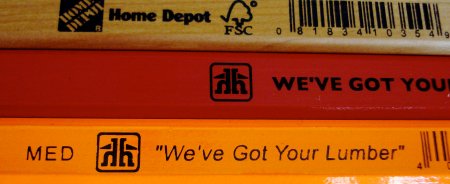
The carpenter pencil has a claim on being the original pencil. The oldest known existing woodcase pencil is a carpenter pencil, seen here at the Faber-Castell website.
This pencil type is defined by the rectangular lead and housing.

Why the shape? The resistance to rolling off a sloped roof is the best explanation I’ve heard.
The ones I’ve seen for sale in Canada are typically octagonal – rectangles with the edges further chopped. But there is also a “chopped ellipse” version.

Hardware stores sell them. Seen here: Home Depot – note the FSC mark – I believe these are made by Musgrave, and were possibly the first pencil in a brick and mortar retail channel with this mark. Also, a couple of pencils from Canadian chain Home Hardware (headquartered in St. Jacob’s, Ontario).

Yet carpenters aren’t the only ones who have appreciated the shape of this pencil. Artists have also found the shape appealing. Here are a few pencils from Derwent, Faber-Castell, and General aimed at artists in the carpenter shape.

The Faber-Castell PITT Sketching 112994 in particular has an exceptional finish, with a thick clear vanish highlighting the natural woodgrain.
Some carpenter pencils from Europe have oval shapes. Additionally, they come in extra long versions. The pencil slat is a highly standardized commodity, and most pencils are about 175mm in length. Yet carpenter pencils also come in 240mm and 300mm lengths. I had read this online some while ago, yet was really surprised to see some in person. Non-novelty pencils made in nonstandard lengths are extremely rare.

Do you use these pencils, either as a carpenter or artist?
This is the first of a four-part mini-series. Tomorrow: The Keson CP2 Carpenter Pencil Sharpener

Hmm, I like these, it looks like some are real good quality, but the carpenter pencils I’ve seen so far in the brick and mortar stores are not really comparable to a good No.V GvFC or a Hi-Uni Mitsu-Bishi.
And I do like to use a good (ufo) sharpener for sharpening, not needing to carry a knife to customers I visit (although I have a small knife on my keychain, but having it and sitting in a meeting, drawing a knife, sharpening your pencil, it just seems well, eeehm, a bit offensive I guess. Would be fun, al those large eyes looking at me, sharpening a pencil with a rather large knife, sharp as $%^&.
But I’m afraid that would cost me just a bit to much customers.
On the other hand, at € 7 per pencil for a No.V from Graf von Faber-Castell, it would save serious money, considering that the carpenters cost a fraction of that.
Well, these pencils are also useful for exactly bricks and mortar :=). When you mark up for bricklaying – these pencils just fit in between two bricks. The oval ones can even move a bit when they’re squeezed in. Most joints (where the mortar goes) are often the same size as the thickness of a carpenter’s pencil.
The very long pencils might be meant for this, as in this case the pencil has to be somewhat longer, than the hight of a standard brick to be useful.
regards
Henrik
Oh, I almost forgot: the blue one marked 333 – HB seem to be Danish? Blyant is the Danish word for a (wooden) pencil.
regards
Henrik
I’ve used such pencils for sketching before, but didn’t really care for them. Unless they’re sharpened to a round point, the flat shape mimics a broad tipped marker. Might be nice for interesting thick and thin marks or calligraphy. But, again, I didn’t enjoy using them. It’s been awhile, though, maybe I should give em another go?
Alec, thanks for your comment. I don’t think carpenter pencils are meant in any way to compete with writing/drawing pencils. Their marks are temporary – and meant to guide a saw or hammer.
Henrik, thank you for that information about using these pencils in brick and mortar work.
And good eye! That is a Lyra Tømrerblyant 333-HB. Here is a closer look:
I would love to learn more about this pencil, which I received from der Lexikaliker.
Thom, thanks for your comment. I suppose broad shading might be a use, yet a pencil like this is probably harder to control.
I used them as a beginner for laying out italic pieces in calligraphy. Properly sharpened the carpenter’s pencil mimics the square cut italic nib. I still have some Derwent ones somewhere – I think.
As for the shape – think of a wooden ruler or square about 5mm thick. Drawing a line with a pointed pencil isn’t that easy. Putting the long side of the rectangular lead against the ruler gives a much steadier line and a chisel edge on the lead is much more durable than a sharp point when you’re marking unplaned timber like roof beams or floor joists.
Not wood-cased but these carpenters’ pencils might be of interest from Lee Valley Tools:
Retractable carpenters’ pencil and 4 leads $3.90
!0 extre leads $2.40
Super pencil ( same shape as a regular carpenters’ pencil) but solid graphite composite 1/4 x 1/2 x 7″ $ 5.70
Multi-purpose graphite marking tool 2 3/4 x 2 x 5/16″ $ 6.30
The humble Carpenter Pencil was a favorite with Vincent Van Gogh. He has used it extensively for sketching and drawing and in combination with pen and ink. See Vincent Van Gogh: The Artist and his Pencils
I hear there are also special sharpeners for carpenters pencils.
the reason for the rectangular shape is…
a) to fit comfortably in the hand for prolonged periods of use.
b) to minimise rolling around the work area.
c) to sit comfortably behind the ear when not being used…
d) to allow a fine edge for marking out dressed (planed) timber in the workshop… yet by simply turning the pencil through 90 degrees… allows a broad line when marking out rough (sawn) timber on the building site (assuming it has been sharpened to a chisel point using a knife not a round ‘sharpener’).
it is the original ergonomic multi-tool…
and as you guys have discussed above, it can also be used in sketching and calligraphy…
P.S. i am a scottish joiner with almost 30 years woodworking experience (workshop, site and in clients homes)…
in scotland carpentry and joinery are one and the same trade/craft… in england they are regarded as totally different…
I got a new carpenter’s pencil the other day that has a level, ruler and magnet all in one.
The pencil is fanatatic.
Check it out here; http://www.terrylove.com/forums/showthread.php?44819-Carpenter-s-Pencil-and-level-in-one-Not-only-that-it-has-a-magnet-and-ruler
Hey pencil experts, I have been searching like crazy for an answer to this question. What do Carpenter pencils have to do with Coffins? A teacher told me that the Carpenter pencils are also called Coffin pencils having to relate to coffin making somehow. Does anybody know about this? I have been googling like crazy and have found nothing that connects carpenter pencils to coffins.
special carpenters sharpeners… they defrat the whole purpose as they produce a rounded point… use a stanley knife to keep the rectangular profile… my previous posting explains why…
coffins… many carpenters were also undertakers in days gone bye… making a coffin is no different from making a large tool box out of beech or oak instead of pitch pine (aka yellow pine or Oregon pine), then using silk or satin on the inside and brass handles on the outside… so it is not to much of a leap for the imagination to understand why carpenter pencils were sometimes referred to as coffinmakers pencils…